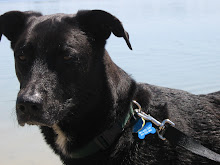On thanksgiving this year we were en route to our thanksgiving dinner, all stressed out and running behind [as usual], when all of a sudden a stray dog jumped out into the middle of the road. My mom freaked [and I think she cried a little] and stopped the car immediately. The dog quickly ran into the neighborhood and my Mom called animal services. It was so sad to know that this cute dog was not going to be in her forever home for thanksgiving, when I so luckily was going to be. I am thankful for my family, but I am sad to know other dogs out there are not as fortunate as me. But you can help (see below)!
Harley's Mission and Iams Home 4 the Holidays (IH4TH) are teaming up to put 1.5 million pets into loving homes by JANUARY 4, 2010! Our goal at Harley's Mission is to help spread the word behind the importance of pet adoption and to assist Iams in achieving this attainable proposition. We know we can do it, but only with your help!
Harley looking for squirrels - 2009
ADOPTION FACTS
- As many as 8 million animals are homeless in the U.S.
- Nearly 4 million orphaned dogs and cats will be euthanized this year due to shelter over-crowding and lack of awareness about the importance of pet adoption.
- More than 25 percent of all dogs in shelters are purebreds.
- IH4TH helped 1,202,751 pets find homes last year alone.
- In Oct. 2008 Hilary Swank adopted Rumi through IH4TH at a Los Angeles shelter.
- Over the past decade more than 3 million pets –1,638,515 dogs, 1,505,690 cats and 134,062 “other” animals – have been adopted through IH4TH.
ABOUT IH4TH
IH4TH.COM is a great resource for anyone who wants to get involved with helping homeless pets - offering tips about adoption, volunteering at a shelter and important information for new pet parents.
Every family that adopts a pet through IH4TH will receive an adoption kit and a DVD loaded with important information including: bringing a new pet into your family training tips, pet care, nutrition information and coupons.
HOW CAN YOU HELP?
- Iams Home 4 the Holidays (IH4TH) needs your help to place 1.5 million pets into loving homes by January 4, 2010!
- With nearly 8 million homeless animals in the U.S. today, and almost half scheduled to be euthanized this year alone, our help is needed now more than ever.
- You can help by adopting a pet this holiday season at IH4TH.com and receive a complimentary adoption kit to help with your new family member.
- Can’t adopt? Join our “Feed Pets in Need” program and help bring much needed food to your favorite IH4TH shelter by simply casting a vote at IH4TH.com.
- Stay updated & be a part of the journey! Every week we’ll be sharing updated adoption numbers on Facebook and Twitter.

Harley sleeping on his first day (forever) home, from the animal shelter, adopted February 2009.










